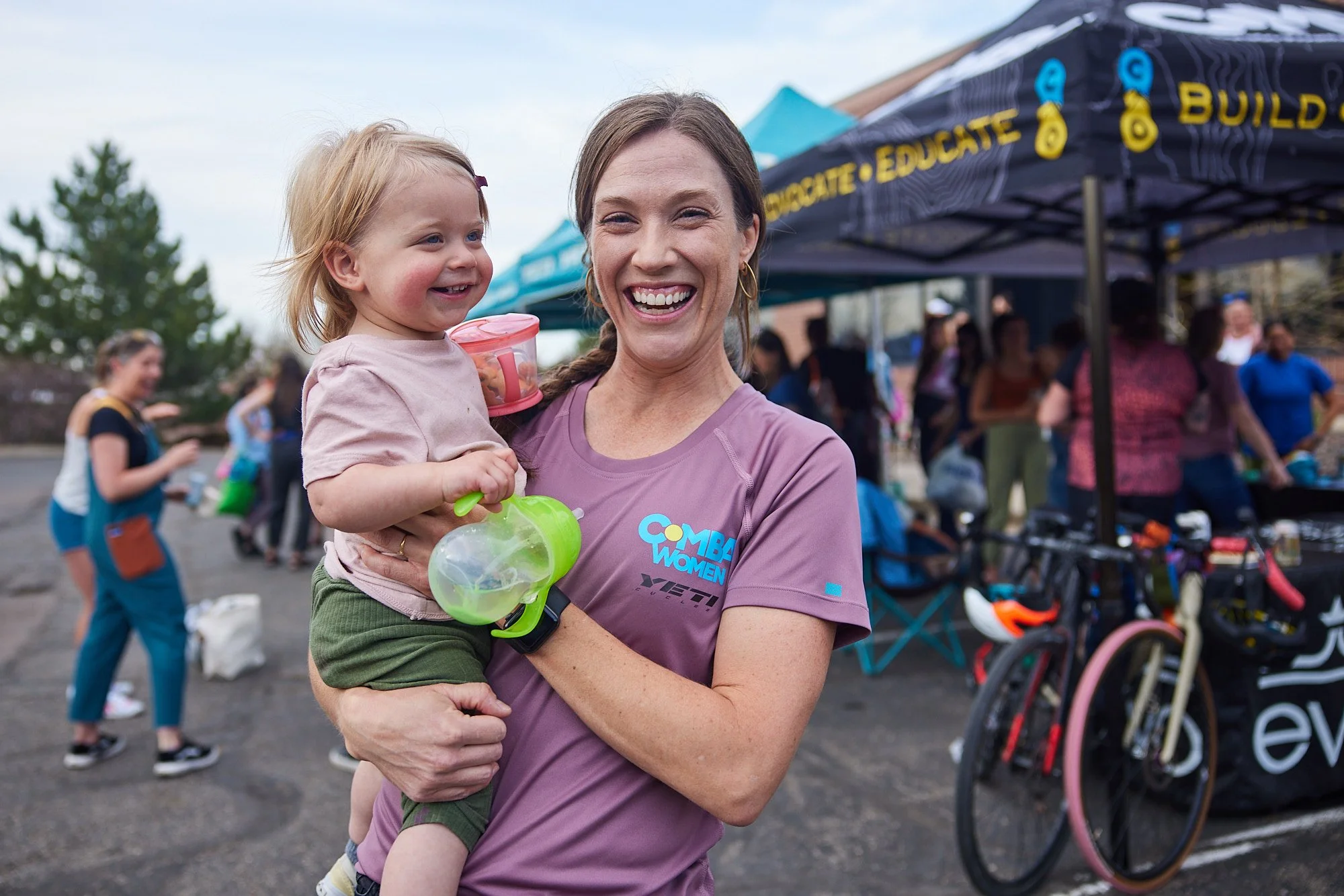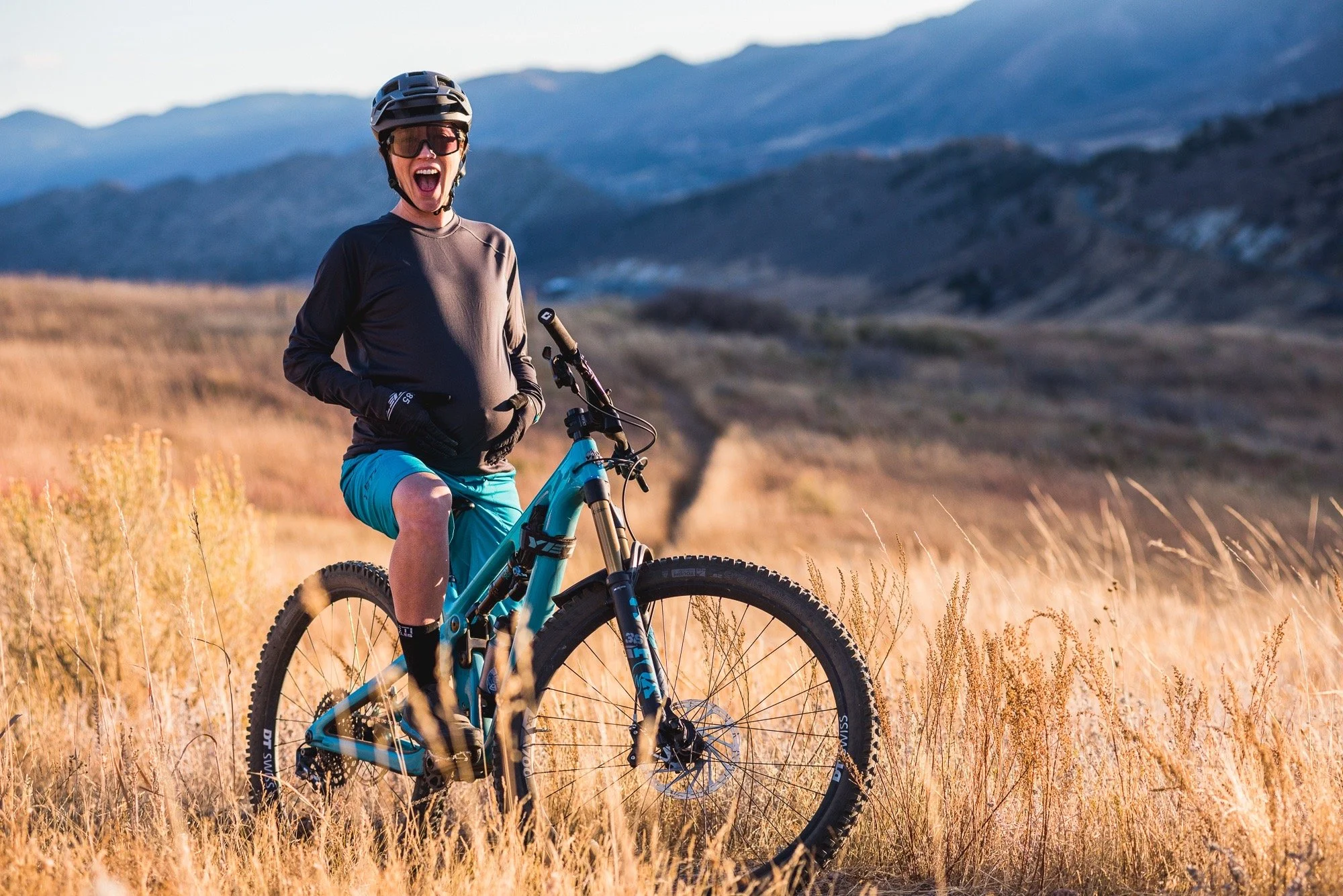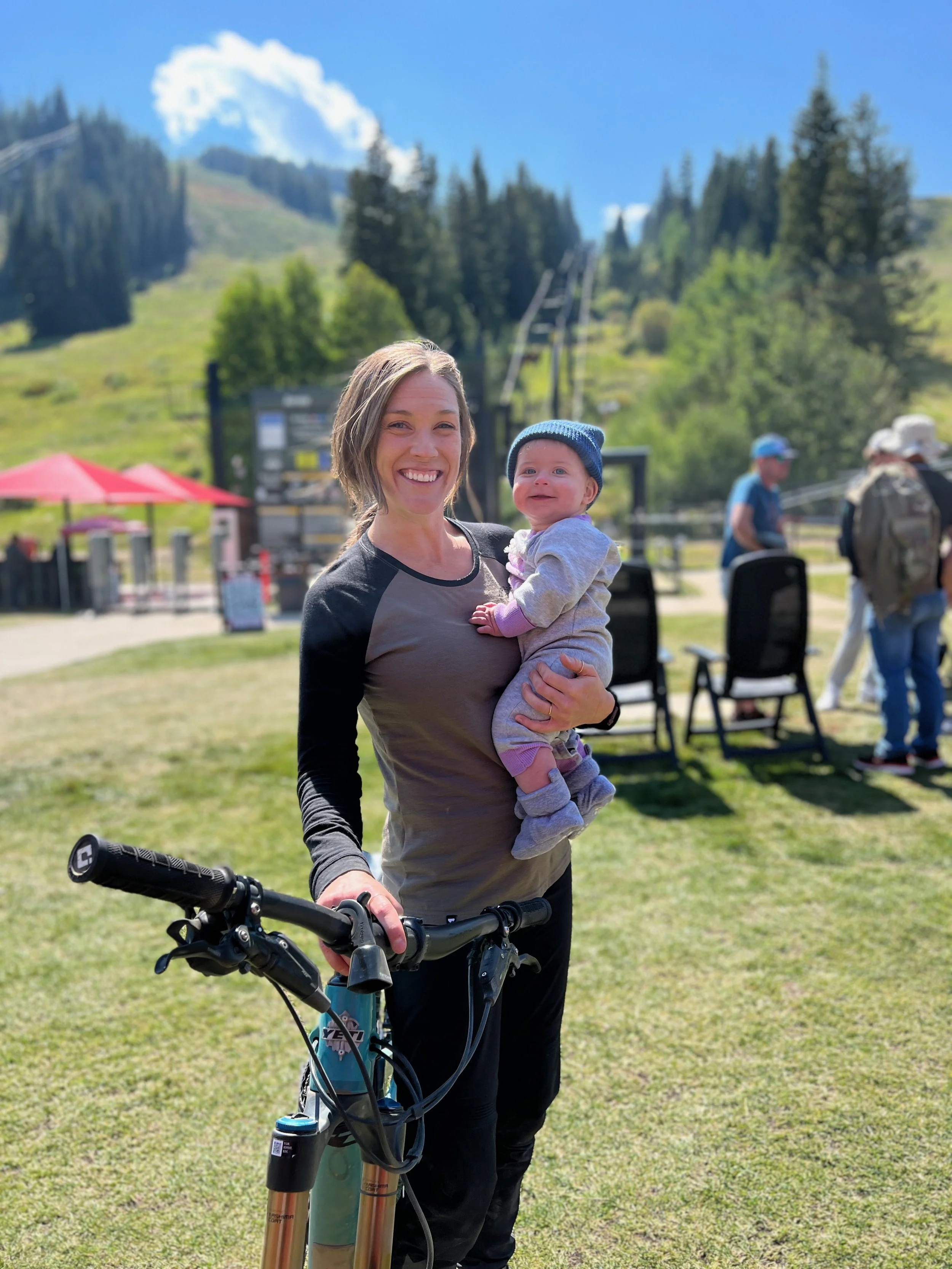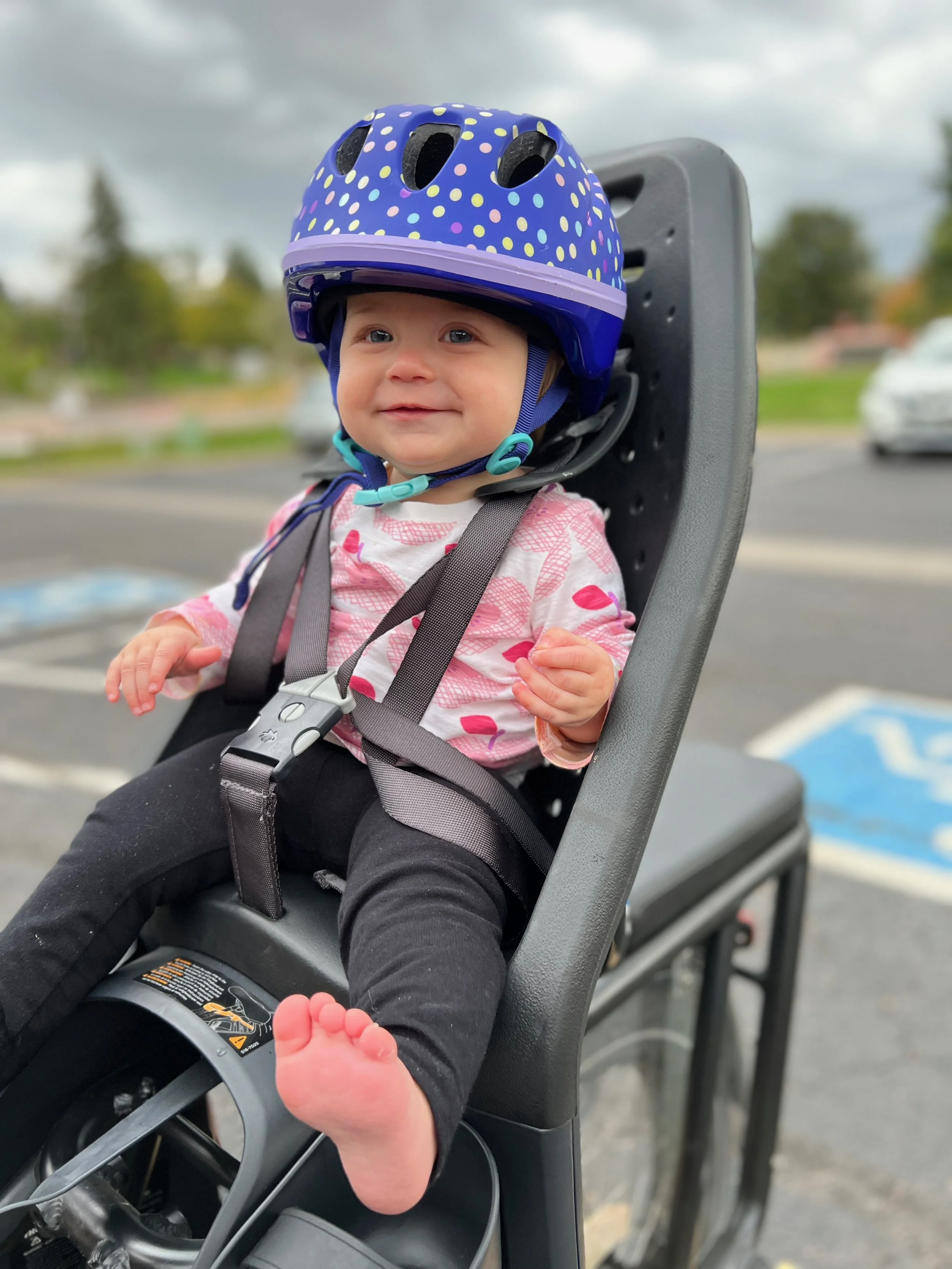Pro Mountain Bike Racer Britt Greer on Balancing Her Passions with Pregnancy
Part 2 in the JOY SEEKERS series, focused on mom athletes and their appetites for risk.
Read the series from the beginning.
Photo: Ian Fohrman
Britt Greer mountain biked until the day she went into labor with her daughter Jo. The professional mountain biker, mountain bike coach, and entrepreneur competes in enduro, a type of mountain bike racing in which only downhill segments are timed. Enduro is a risky version of the sport because your success is dependent on your ability to hit technical downhill features at high speeds, often after climbing several thousand feet. She also bikes for fun, with friends, with her husband Ian, and while coaching other women.
Biking while pregnant was a necessary part of her self care, especially while much of her identity transformed surrounding pregnancy and planning for birth.
“I've never felt stronger, more confident, and more badass. I was biking up a mountain nine months pregnant and passing dudes. No podium is cooler than that,” she said.
Photo: Ian Fohrman
A Close Call
Eleven weeks into her pregnancy, Britt fell off her bike on a trail near her home in Golden, CO.
“I rammed my lower back into a railing on a bridge at Apex Park. I got home, got in the shower, and started peeing blood. I panicked and screamed and [my partner] Ian came running upstairs. I was certain that I had lost this baby. We both crumpled to the floor and started crying. We hadn't realized how much we wanted Jo until that moment. I was like, ‘Oh my God, we want this baby so bad and this is horrible. I've put myself first and now I've maybe killed this little thing in me.’ We went to the ER and got a bunch of tests and the first thing they did was test the baby's heartbeat. And the heartbeat was okay. And it turns out that I had really badly bruised my kidney.”
To Britt, who’s been mountain biking for over 13 years, biking felt nearly as safe as walking. But the fall rattled her. “It was definitely a rude awakening. I asked myself, ‘What does pregnancy look like for me now?” I had this vision of biking and wondered, ‘Do I not bike anymore?’ And I knew it wasn’t just my decision. It was also Ian’s.”
They decided to set some boundaries, and Britt agreed not to bike any black diamonds and to avoid any trail she hadn’t biked before. She biked slowly and stayed in the back to avoid the pressure to speed up.
“I had to change my mentality. I decided I needed to just be grateful to be on that bike,” she said. “I didn’t care what I had to ride. So I rode the front side of Apex Park right in my backyard, and then I would walk down the technical stuff even though I knew with confidence that I could do it. I had promised Ian that I would walk these things, so I walked them.”
“Your little heart is beating inside me and you’re feeling all these bumps and you’re seeing how much joy this is bringing mommy.’ It was so, so special.”
The First Lesson of Parenthood: Trust Your Gut
Even with the rules Britt and Ian set, they sometimes feared judgment from others, and had to trust their own instincts about what was best for Britt, and for their baby.
“I remember the ER doctor told me that everyone was going to judge me [for biking while pregnant]. And that it was ok, because I could have just as easily fallen off a ladder. She told me, ‘Accidents happen. And for you, biking is like walking or hiking. You have to make your choices and listen to your instincts.’”
When her family told her to stop biking, Britt told them she had, for a while. “Finally I was like, I am okay. This baby means more to me than anything. I am her mother. I can make these decisions for us. I’m capable of it and I want nothing more than for her to be safe.”
For healthy women with healthy pregnancies, exercise is not only safe, but encouraged, according to The National Institute of Health’s 2015 clinical review, “Exercise in Pregnancy.” “In general, women who are physically active prior to pregnancy should be advised to maintain, and counseled that they can increase, their level of activity if desired, while physically inactive women should be encouraged to begin exercising,” it states. However, the review is inconclusive regarding other specific benefits of exercise during pregnancy, including reduction in Cesarean section rates, appropriate maternal and fetal weight gain, and managing gestational diabetes.
Like many women’s health topics, the research is sparse and recommendations tend to be conservative and in favor of risk avoidance. The general advice from doctors is that anything you were doing before getting pregnant should be safe to continue doing. The Mayo Clinic advises that a pregnant woman should be able to carry on a conversation while exercising. They also warn against anything with a heightened risk of falling (like biking, skiing, or surfing), in addition to anything that strains the body in other ways (e.g. scuba diving) because of risk to the placenta and umbilical cord in the early months, and later the risk of premature labor. One study of Olympic-level athletes found that when women pushed their heart rates to 90 percent of their maximum during pregnancy, there was some decreased blood flow to the baby.
For Britt, continuing her pre-pregnancy activity meant biking up the switchbacks at Apex Park around the corner from her home. For others, a daily activity is more like a morning dog walk or yoga routine. For me, it meant mid-elevation (around 8,000 feet) hikes with my dog to pull me up the steep hills.
“I think if you stay fit during pregnancy it's pretty easy to keep it going,” she said. As she continued to bike, Britt formed a bond with her growing baby. “I had this cool connection with her. I'm like, ‘Josie, we are climbing this now. Your little heart is beating inside me and you're feeling all these bumps and you're seeing how much joy this is bringing mommy.’ It was so, so special.”
The Business of Pro Sports
Britt’s sponsors—Yeti Cycles, Wilderness Trail Bikes (WTB), and Deuter—have supported her from the beginning of her pregnancy, and she’s felt no pressure to continue racing at her former level. And if she did feel that pressure, she says she would likely give up the sponsorship. “A really cool part of being a mom is that it puts everything into perspective. All the things that I used to stress about that I thought were so important are all of a sudden not important at all. I feel like there's less pressure and people have respected me as a mother in a different way.”
Britt’s experience is a far cry from athletes like Olympic medalist and six-time USA Outdoor Track Champion, and mom of three, Alysia Montaño, who faced intense pressure and a lack of support from sponsors like Nike and Asics, even as she continued to train and compete through pregnancy and postpartum.
Alysia, who won national championships six and 10 months postpartum while still nursing, fought for legislation to protect mom athletes with basic rights like health insurance and a contract guarantee for 18 months surrounding pregnancy, whether or not they are able to compete at pre-pregnancy levels—or at all—during that time.
Alysia is also the co-founder of &Mother, an organization dedicated to removing barriers to allow mothers to fully participate and succeed in sports, a goal that will pave the way for all mothers in all industries to pursue their goals. Through a mix of storytelling, a grant program, and working directly with sponsors who want to better support their mother-athletes, they aim to enable women to thrive in motherhood and in their careers. Her hope is that professional athlete moms no longer have to choose between starting families and continuing their careers.
Photo: Ian Fohrman
“Those big injuries and big crashes haunt me, sometimes they go on repeat in my mind. I don’t want to experience that ever again, especially now.”
Back on the Bike
Six months after giving birth, Britt competed in an enduro bike race. “I wanted to find out if this was something I still found joy in,” she said. “Is this a passion that I want to chase and pursue and something I want to carve out time for in my life? Because it’s not just showing up to race. You have to train and get the mentality and progress. So I set the intention that I was just going to be as strong as I could be and not have a specific training program. But I don’t cross train much. I don’t have time for that anymore.”
Her appetite for risk changed, too. “I used to show up to races ready to give it my all and push myself through so many scary things. There’d be a big drop that I would be dreading days before, knowing I had to do it and push through that fear. Before, I was willing and wanting to push through that fear.” As a result, sometimes she got injured. Like in 2018 when she shattered her collar bone in more than five places on a Teton Pass jump. The resulting surgery left her with a permanent metal plate and more than six months of recovery.
“Those big injuries and big crashes haunt me, sometimes they go on repeat in my mind. I don’t want to experience that ever again, especially now.”
Scaling back on risk can feel like a big sacrifice for elite athletes, and not just because it will likely hurt their performance. Every time a person takes a risk, they get an unusually big hit of dopamine, the compound responsible for pleasure, satisfaction, and motivation. That blast of dopamine can be addictive, which is why those who get hooked on it tend to keep pushing themselves to pursue bigger and scarier challenges. Professional mountain athletes’ appetites for risk tend to be higher than the average person, possibly because they are born with fewer dopamine receptors than the average person, according to a 2008 study in the Journal of Neuroscience. That craving for dopamine may be what makes them more likely to compete in risky sports in the first place.
Rather than focus on the podium and setting personal bests like she would have before, Britt chooses to focus on baby Jo. Toning down the intensity doesn’t feel like a sacrifice right now. “There were moments mid race when I knew I could go faster. In the past when I was in the zone I didn’t have time to think. I was just in it. And now my mantra became, ‘Stay safe, have fun, Jo’s at home.’”
While Britt says she used to ride in the 80/20 zone—80% totally confident and safe and within her ability level, and then 20% on the edge or pushing the limits of fear—those numbers shifted in her first postpartum race. Now she rides in the safe zone 95% of the time.
“Five percent was like, ooh I’m going a little too fast, or I’m pushing a little too hard. Normally I would push through that and be like, ‘It’s ok, you’re safe. You’ve got this, you’re a talented rider.’ Now I'm like, ‘If you’re going too hard, maybe pull back a little bit.’ This may be my new normal, and I’m ok with that.”
She cites both motherhood and age as reasons for that more cautious approach. “I don’t want to be ridiculously throwing myself off things at 40 just to progress. For what?”
“I just want her to be passionate about something, because I do think passion pushes you to be better. It pushes you outside of your comfort zone. It pushes your limits, and it makes you confident. It just brings so many good things to your life. I want her to experience life however she wants to experience it, but in a confident way.”
Photo: Ian Fohrman
As director and founder of the Colorado Mountain Bike Association’s (COMBA) Women’s Program, Britt finds plenty of time to get out on her bike. Her mostly volunteer-run nonprofit is on a mission to get more women riding by introducing them to the joy and passion of the mountain bike community. COMBA hosts hands-on mechanics classes where women learn how to work on their bikes, monthly rides, and clinics where they get coached by professional, licensed coaches. They also host trail work days and gear-sharing events.
Now Britt and Ian are raising a Colorado kid who loves getting outside on her own little bike. And Britt says she’s ok with the idea of Jo taking risks the way she does.
“I just want her to be passionate about something, because I do think passion pushes you to be better. It pushes you outside of your comfort zone. It pushes your limits, and it makes you confident. It just brings so many good things to your life. I want her to experience life however she wants to experience it, but in a confident way.”
Coming soon: Skimo racer Jessie Young on raising kids in a ski town and why avalanche territory is no longer worth the risk.





